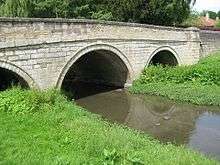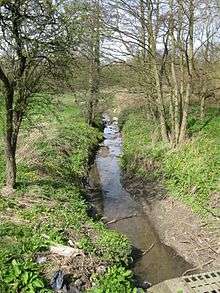Cock Beck
Cock Beck is a stream in the outlying areas of East Leeds, West Yorkshire, England, which runs from its source due to a runoff north-west of Whinmoor, skirting east of Swarcliffe and Manston (where a public house has been named 'The Cock Beck'), past Pendas Fields, Scholes, Barwick-in-Elmet, Aberford, Towton, Stutton, and Tadcaster, where it flows into the River Wharfe.



It is a tributary of the River Wharfe, formerly known as the River Cock or Cock River,[1][2] having a much larger flow than today.[2] The name 'cock' may refer to a mature salmon, as it was a spawning ground for salmon and trout.[3] Industrial pollution reduced the fish stock, but it has been recovering in the 21st century, aided by work from the Environment Agency.[3] In places the beck was relatively narrow, but too deep to cross unaided; a feature which can still be seen today at many points.
History
The Great North Road crossing at Aberford was first a Celtic trackway and later a Roman road. It is defended on the north side by 4.5 miles of Iron Age fortifications known as the Aberford Dykes which run from a hill fort at Barwick-in-Elmet, through Aberford and a mile east, consisting of a ditch and ridge. It is believed that this was a defensive construction of the Brigantes against southern tribes and the Romans.[4] The river may have been engineered to increase the barrier.[2]
Cock Beck is identified as a likely site of the Battle of the Winwaed on 15 November 655, a decisive victory of Oswiu of Bernicia over King Penda of Mercia.[5]
The beck is thought to be the one after which Becca Hall, whose name is first attested, as Becca, in 1189, is named.[6]
In the aftermath of the 1461 Battle of Towton remnants of the Lancastrian forces fleeing the victorious Yorkists were forced to try to cross the Cock Beck, having already disposed of most of their arms.[7] Many drowned in the Beck, and soon the survivors were reported to be crossing the Cock Beck on bridges of their fallen comrades.
During the English Civil War, the Royalists defeated the Parliamentarians under Sir Thomas Fairfax at the Battle of Seacroft Moor in 1643. The ensuing massacre of the Parliamentarians is said to have been of such magnitude that the beck ran crimson with blood.[8][9]
John Ogilby's 1675 map indicates the major crossing for the Cock was sited along the Tadcaster-Ferrybridge road.
References
- Langdale, Thomas (1822). A Topographical Dictionary of Yorkshire (2nd ed.). J. Langdale. p. 211.
- Armfield, H. M. (2011). A History of Aberford (2nd ed.). available from St Ricarius Church, Aberford. p. 2.
- "River cleared for returning salmon". BBC News. 18 December 2002. Retrieved 24 October 2014.
- Leslie Alcock (1954) Antiquity Volume 28, Issue 111 September 1954, pp. 147-154 "Aberford Dykes: the first the Brigantes?
- Campbell 1995, p. 8.
- Harry Parkin, Your City's Place-Names: Leeds, English Place-Name Society City-Names Series, 3 (Nottingham: English Place-Name Society, 2017), p. 22.
- Towton Battlefield Society (2007) Battle of Towton Map and Guide (3rd ed)
- "Mediaeval Battles within the boundaries of Elmet". Archived from the original on 4 February 2009. Retrieved 24 October 2014.
- "The Battle of Towton 1461". Archived from the original on 12 October 2009. Retrieved 24 October 2014.
- Campbell, James (1995). Essays in Anglo-Saxon History. Hambledon Continuum. ISBN 978-0-907628-33-0.
| Wikimedia Commons has media related to Cock Beck (River Wharfe). |